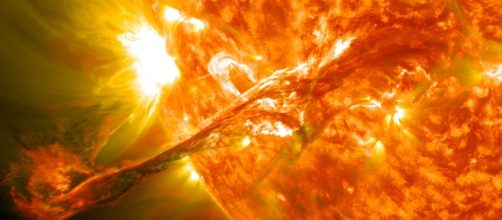The Sun emitted two high-intensity Solar Flares, the second of which registered as the biggest wave seen in the past 12 years. The explosive Category X waves were powerful enough to kill both of Earth’s high and low-frequency communication waves for a full hour.
Powerful solar flares and the sun cycle
NASA captured the explosion of two powerful solar flares. According to Space, the recent eruptions were classified as X-class solar flares, the most powerful category. The eruption originated from one large spot in The Sun. The powerful flares were captured by NASA ‘s Solar Dynamics Observatory Satellite.
According to Daily Mail, the powerful solar explosions originated in one of the Sun’s active region. The same region was also the origin of the mid-level intensity eruptions observed last September 4.
The solar explosions occurred towards the end of the active face of the current sun cycle. On an average, solar cycles last for up to 11 years. As cycles approach its end, solar activity decline. Despite the rare occurrence, cycle end flares tend to be more powerful and explosive.
The recent solar flare eruptions were classified as X-type flares. As described by Space, X-class solar flares are the most powerful types of solar storms which erupt from the spots on the sun’s surface. The first wave was classified as an X2.2 easily became the strongest flare observed since 2015.
However, 3 hours later, a second flare erupted. The second flare was classified as an X9.3 flare which instantly dwarfed the first eruption. History shows that most recent flare that displayed a similar intensity was an X9 flare which about 12 years.
The science behind solar flares
Solar flares explode when the magnetic field of the sun twists and reconnects. The sun’s magnetic field caused the formation of dark sunspots on the star’s surface. The magnetically filed activities result to an outward blast of energy that dramatically increases the solar surface temperature.
Solar flares are classified according to strength using the letters A, B, C, M and X. A-class flares are the smallest explosions.
Measuring the strength of flares is similar to the use of the Richter scale for earthquake magnitude. As the solar flares climb from classification A to X, its power increases 10-fold. X category flares carry gigantic amounts of radiation which have an impact on planet Earth.
Destructive radiations from flares cannot entirely penetrate Earth's atmosphere. Hence, they have no physical effect on humans on the ground. However, intense explosions are capable of reaching the atmospheric layer which hosts Earth’s GPS and communications signals. In fact, the recent X-class flares have killed both high and low-frequency communication on Earth for an entire hour.


